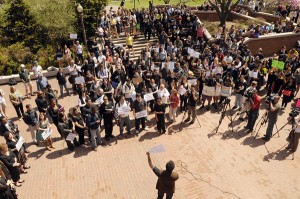I’m halfway there! Well, I’m halfway there of finishing my first year in college at least. I’m still 3.5 years away from my college graduation, so I still have a long way to go. Looking back on my first semester at Trinity, there are a couple of things I would have done differently if I could redo my whole first semester. However, I am extremely proud to be the student I am today: a student who has successfully completed his first semester at Trinity, a student who has endured struggle after struggle and learned from his mistakes, and a student who is ready to make his second semester at Trinity better than his first. College is a whole new world. The transition from high school to college is very difficult. You are entering a new social environment and a new academic setting that takes time to accustom. What can I do to make the transition from high school to college easier and smoother? Take advice and tips from those who have experienced the difficulties of acclimating to the college’s atmosphere. Here is my advice to anyone who is about to start college: Read Andrew Roberts’ The Thinking Student’s Guide to College—specifically his tip #46 which I found to be the most valuable—and consider taking my advice of utilizing all available resources on campus—specifically the counseling center which I found to be the most helpful.
Adolescents never listen or take advice until they experience struggles in a situation where they are forced to take it. I ignored and pushed away all the people who were trying to give me advice about college before I headed to Trinity. “I got this” is what I told them. However, I realized that I didn’t “have it” when I started struggling with both academic and personal problems. I wished I could go back in time and listen closely to the advice I was given from my family, friends, and teachers. Rereading The Thinking Student’s Guide to College by Andrew Roberts made me realized how helpful his tips would have benefited me if I applied them earlier in the semester. In this book, Roberts introduces 75 tips for getting a better education. This book gives excellent advice, and I believe that these tips will help any freshman achieve his or her educational goals for next four year at Trinity College. This prestigious, private, and small liberal arts school has a very challenging and high-quality academic curriculum. Therefore, expect to work hard because nothing will be easy.
Graduating top five from a college prep high school with a G.P.A above a 4.0, I thought I had nothing to worry about, which gave me the confidence of saying, “I got this.” Achieving the grades I wanted in high school was extremely easy. I easily earned straight “A’s” by independently working hard without asking help from my friends and teachers. I thought I could earn straight “A’s” in college by following the same academic routine I had in high school. My obsession with getting straight “A’s” in my first college semester was a mistake because I kept getting paranoid when I get a “B” or a “C” on an assignment or test. I didn’t seek out help when I really needed it because I thought it showed a sign of weakness. However, now I know that asking for help is showing your professors that you care about your education and that you are an extremely hard worker. I learned this precisely by reading tip #46 in Andrew Roberts’ The Thinking Student’s Guide to College
“Show Professors That You Are Working Hard” is what tip #46 states. Andrew Roberts mentions, “By attending class, by completing your assignments on time, by participating in class discussions, and by showing up at your professor’s office hours” shows your professors that you are working hard and care about the class (96). I never went to my professors’ office hours, not even once. Looking back, I wished I would have gone regularly because it would have shown a sign of strength and dedication—and not weakness. If I would have attended my professors’ office hours and participated more in class more, I am positive that I would have earned the straight “A’s” I wanted. However, my obsession with “the perfect grades” soon changed when Jack Dougherty said, “It is not all about the ‘A’ you get in class; it is about what you get out of it.” I stopped being overly obsessed with my grades and started focusing more in class. I am not saying that getting straight “A’s” is impossible, but it will be hard work and reading some of Roberts’ tips will make things easier because you will have a map that will help you have a valuable educational experience. If a freshman wants to have the best educational experience here at Trinity, I recommend reading some of Andrew Roberts’ tips in order to have a successful four years in college.
“Freshmen year of college is always the hardest one” is what everyone says. I say that it all depends on the student. I have met students here at Trinity who came from boarding schools who found the transition from high school to college to be very easy. However, I also came across students who struggle in acclimating to the college life here at Trinity, much like me. In reality, there are going to be students in college who are more academically and personally prepared than others. Even though my classmates learned the material quicker than I did, I still felt I was academically prepared to handle all of the academic challenges that I came across. I never really encountered personal problems back home in Chicago. However, I found myself personally struggling here in Hartford, Connecticut on an emotional level.
Homesickness, depression, and guiltiness are uncontrollable emotions. I never experienced feelings this strong that invoked sadness, discouragement, despair, and hopelessness. I thought that these emotions were temporary, but they got worse the longer I waited to seek help. As days passed, the further away I was from myself. I found myself locking myself in my dorm room; I found myself sleeping more than usual; I found myself not eating; I found myself losing weight; I found myself getting extremely sick; I found myself crying; I found myself having trouble concentrating; I found myself not doing work or studying; I found myself not going to class; I found my grades slipping in all my classes. Most importantly, I found myself losing all the energy and motivation I had when I first arrived in Connecticut.
I was foolish enough not to seek out help when I was at my worst. I am very lucky to have a caring advisor like Stefanie Chambers who took me to the counseling center. At first, I didn’t want to go to counseling because I didn’t want help and because I thought only “crazy” people went to counseling. However, I soon discovered that many Trinity students go to the counseling center to deal with their stress and their other problems. Looking back, I am so happy that I gave counseling a chance because it really did help control my emotional distress. I felt more relieved, and I learned how to control these intense feelings. I wished I would have gone to counseling earlier, so it wouldn’t have drastically affected me physically, academically, socially, and personally. You don’t have to experience the same feelings as I did to go to counseling. Many Trinity students—freshmen, sophomores, juniors, and seniors—have struggles. Dealing with stress is overwhelming and seeking out help is the wisest decision you can make. Going to the counseling center will help you cope with your stress. Most importantly, counseling is free here at Trinity. You have nothing to lose if you try it. Please, take advantage of this resource and use it. Trust me, you won’t regret it.
How is going to counseling going to help me get a better education? The key to a better education is having a healthy body, mind, and soul. I had trouble concentrating, studying, and completing homework assignment when I was dealing with my depression, homesickness, and guiltiness. As a result, my grades slipped. When you first identify a problem, do not be afraid to seek out help. Yes, it will be hard at first to get help when you never received help in the first place. However, do not hesitate to make an appointment at the counseling center. I was absolutely sure I wanted to leave Trinity after this semester when I was coping with my feelings. Nevertheless, counseling made a huge difference in my life, and I am extremely proud of myself that I decided to stay here at Trinity College to receive the best education I deserve. Utilize all resources on campus and seek out help when you are having trouble because only the strongest and dedicated of students will try their greatest to have the best educational experience.
Here is the current information of Trinity College’s Counseling Center:
135 Allen Place (Right on Vernon St. behind the Campus Safety building)
Phone: (860) 297.2415
Fax: (860) 297.2428
Email: Randolph.lee@trincoll.edu
www.trincoll.edu/studentlife/healthwellness/counseling/pages/
Bibliography:
Roberts, Andrew Lawrence. The Thinking Student’s Guide to College. ; 75 Tips for Getting a Better Education. Chicago: University of Chicago, 2010. Print
About the Author:
Tommy is a Hispanic male from Chicago, Illinois. Tommy graduated from Noble Street College Prep ’11. He is a student at Trinity College ‘15, and he is a Posse Scholar. Tommy is in Professor Jack Dougherty’s first-year seminar, “Color and Money.”





